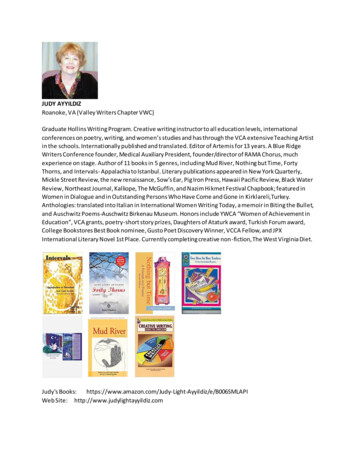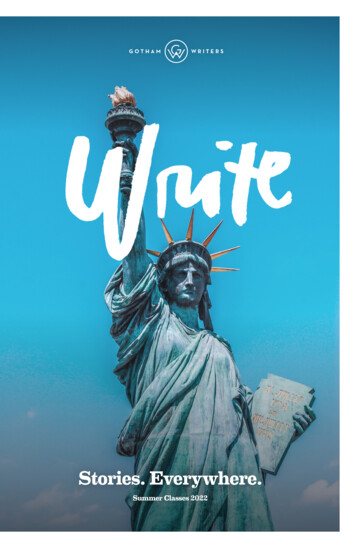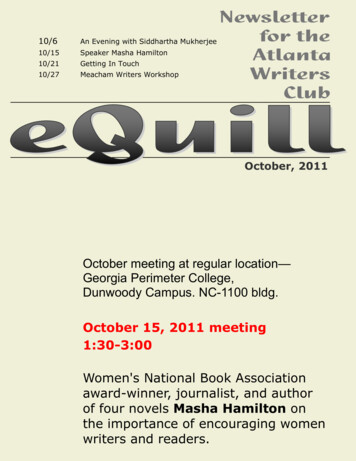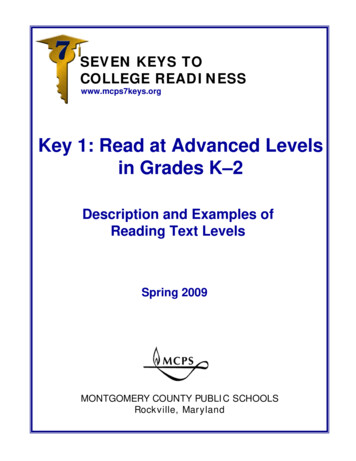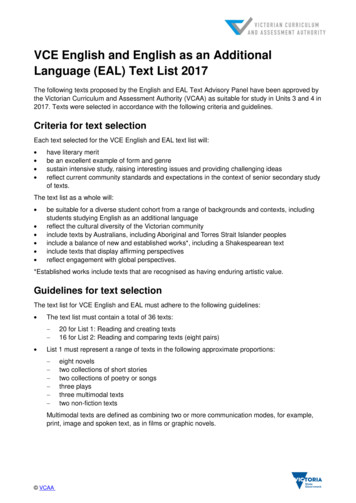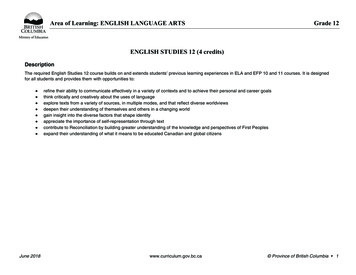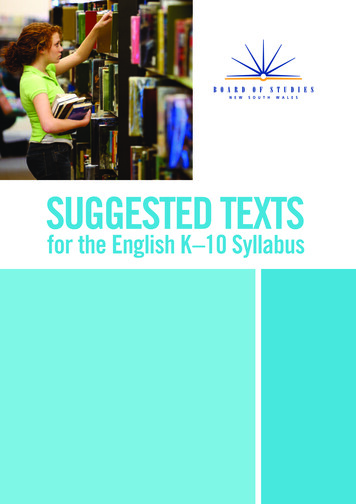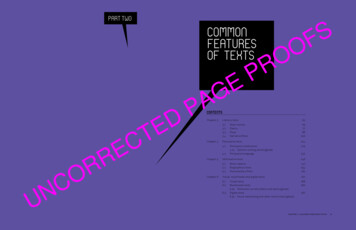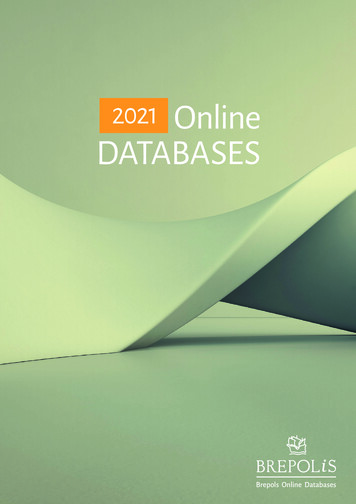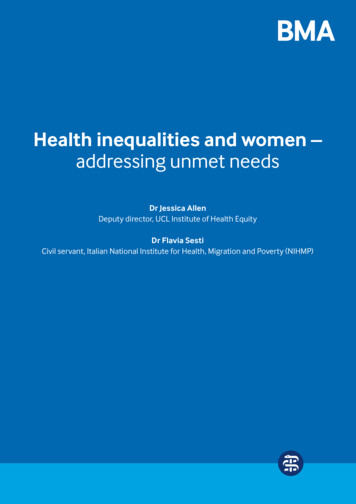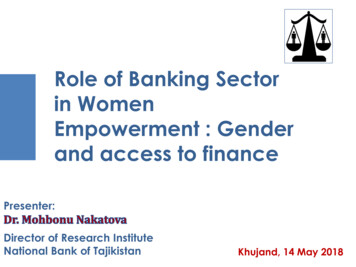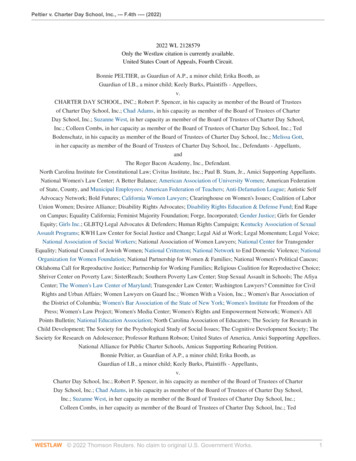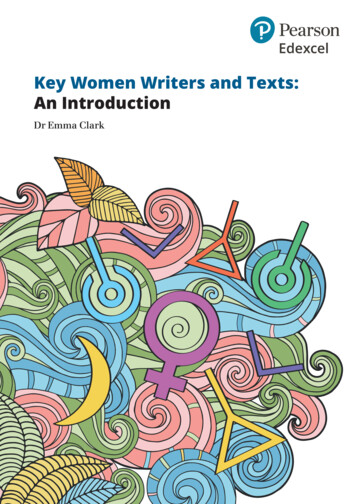
Transcription
Key Women Writers and Texts:An IntroductionDr Emma Clark
Below is a very select list of writers and texts that you may want to suggest toyour students – or add to your own reading lists. As with all lists, it is notcomprehensive, but all are texts which could be studied and enjoyed bystudents whilst completing the NEA/coursework component for the A levelEnglish Literature qualification.Most of these writers and texts have a great deal of critical material writtenabout them which should be easily accessible to most students. A useful startingpoint would be the British Library website which has recently been updated. TheBritish Council website also have a searchable database of British andCommonwealth writers which outlines their works and includes somereferences and critical perspectives.There are also three useful NEA/coursework guides covering Contemporary BlackBritish Writing, LGBTQ Literature and British Asian Literature on the Pearsonwebsite which contain works by women writers.There are a number of interesting anthologies and lists of women writers whichmay give you some ideas about some new women writers to introduce to yourstudents and to help them to select authors they may wish to study more closelysuch as: Becca Anderson, Book of Awesome Women Writers (2020) Ann Sandham (ed), The Women Writers’ Handbook (2020) Sandra Gilbert and Susan Gubar (eds), The Norton Anthology of Literature byWomen (2 vols), (2008). Elaine Showalter (ed), The Vintage book of American Women Writers (2011) Maren Tova Linnett (ed), The Cambridge Companion to Modernist WomenWriters (2010) Angelyn Mitchell and Danille K Taylor (eds), The Cambridge Companion toAfrican American Women’s Literature (2009)Please also refer to our coursework guidance document.1Pearson Edexcel Level 3 Advanced GCE in English Literature – Key Women Writers & Texts – Issue 1 – March 2022 – Authorand Approver: GQ Product Management – DCL1 Pearson Education Limited 2022
Julian of Norwich (c1343–c1416) was a female anchoress whose works, knownas Revelations of Divine Love, are thought to be some of thefirst writings by a woman in the English Language. As shewas a deeply devout woman, her works focus on the loveand nature of God. A digitalised version of her manuscriptscan be found on the British Library with a modern editionpublished by Oxford World Classics. There is also aninteresting page on Wikipedia which outlines the historyand publication of her works.Margery Kempe (c.1373–c.1438) was a Christian mystic who wrote about herlife and beliefs in what is thought to be one of the first examples ofautobiographical writing in English. Her book, The Book of Margery Kempesurvives as a manuscript in the British Library and modern academic editions ofthe text have been produced and are readily available with introductions andglossaries.Mary Sidney, Countess of Pembroke (1561–1621) was an early patron ofwriters and artists in Early Modern England and the sister of the poet, Sir PhilipSidney. She wrote a number of poetic works and her closet drama, Antonie(1595), which was read aloud rather than performed, was translated from aFrench drama and discusses the relationship between Antony and Cleopatra.Her niece, Lady Mary Wroth (1587–1561) also wrote poetry and drama and herpastoral drama, Love’s Victory (1620) as well as her prose romance, Urania (1621)are thought to be the first of their kind.Margaret Cavendish, Duchess of Newcastle (1623–1673) is thought to be oneof the first women to publish her work under her own name. She wrote a greatvariety of works from her poetry to philosophical and scientific writings. Herprose romance, The Blazing World (1666), has been seen by some critics as anearly example of science fiction writing. The British Library website has someinteresting information about her life and career.Aphra Behn (1640–1689) is thought to be one of the firstprofessional female writers. Her slave narrative, Oroonoko, or theRoyal Slave (1688) has a female narrator which allowed her tohighlight the issues surrounding women at the time as well asher own views about the slave trade and politics. Her play, TheRover (1677), is known as a restoration comedy and is stillperformed today.2Pearson Edexcel Level 3 Advanced GCE in English Literature – Key Women Writers & Texts – Issue 1 – March 2022 – Authorand Approver: GQ Product Management – DCL1 Pearson Education Limited 2022
Charlotte Smith (1749–1806) was a Romantic novelist and poet. She is bestknown for her poetry, which used the sonnet form to discuss Romantic themessuch as nature and personal feelings about life and love.Frances (Fanny) Burney (1752–1840) is perhaps best known for her novels, butshe also wrote plays as well as some more autobiographical works. Her best –known novel is Evelina (1788), which is an epistolary novel following the life ofEvelina, an aristocrat’s daughter, who grew up in the countryside and comes toLondon at the age of 17. The British Library website has some usefulinformation about Burney’s life and legacy.Phillis Wheatley (1753–1784) was sold into slavery when she was very youngand became the first African American poet to be published. Her work, Poems onVarious Subjects, Religious and Moral (1773) focus on the politics of the time aswell as her religious and spiritual beliefs. This blog from the ZSR library in NorthCarolina outlines the history of the work.Mary Wollstonecraft (1759–1797) was a writer andphilosopher whose work, A Vindication of the Rights of Woman(1792) is viewed as an influential work in feminist thought andtheory. She also wrote novels – Mary (1788) and Maria (1798) –in which she expressed her views on marriage andrelationships.Anne Radcliffe (1764–1823) is widely viewed as one of the first writers of Gothicfiction. The Mysteries of Udolpho was published in 1794 and featured the nowwell-known tropes of the Gothic genre. It was later satirized in Jane Austen’sNorthanger Abbey (1818). There is an interesting introductory essay to AnneRadcliffe on the British Library website.Maria Edgeworth (1768–1849) was a prolific author of fiction for both adultsand children. She travelled extensively and also met many popular authors ofthe time. She is perhaps best known for her novel, Castle Rackrent (1800). Set inIreland, this short novel tells the story of the Rackrent family and is an earlyexample of historical fiction.3Pearson Edexcel Level 3 Advanced GCE in English Literature – Key Women Writers & Texts – Issue 1 – March 2022 – Authorand Approver: GQ Product Management – DCL1 Pearson Education Limited 2022
Jane Austen (1775–1817) is one of the best –known authors in the world andher novels are still enormously popular. Her six novels– Sense and Sensibility (1811), Pride and Prejudice(1813), Mansfield Park (1814), Emma (1815), NorthangerAbbey (1818) and Persuasion (1818) – all focus onfamily life, marriage, love and relationships as well astaking a satirical view of Regency society. Manymodern critics read the novels as a critique andcomment on the patriarchal society of Austen’s timesand praise the largely female perspective representedin the novels.Elizabeth Barrett Browning (1806–1861) was an English poet who was marriedto the English poet, Robert Browning. She is perhaps best known for her Sonnetsfrom the Portuguese (1850) and Aurora Leigh (1856). Browning’s life and work isdiscussed on the Poetry Foundation website and the social and political contextsof her works are discussed in two articles on the British Library website.Mary Shelley (1797–1851) was the daughter of Mary Wollstonecraft and WilliamGodwin, and she wrote perhaps one of the most famous novels of moderntimes. Frankenstein, or The Modern Prometheus (1818) uses multiple narrators totell the story of Victor Frankenstein, who creates his own creature in a scientificexperiment. Shelley’s work is discussed in this article on the British Librarywebsite.Charlotte Bronte (1816–1855) was the eldest of the three Bronte sisters andwrote many novels and works of poetry during her lifetime. Her most famouswork, Jane Eyre (1847), tells the story of Jane Eyre and her relationship with MrRochester, the owner of Thornfield Hall where she is a governess. Bronte usesher titular heroine to investigate such themes as class, gender roles,relationships and religion. The novelist Jean Rhys famously wrote Wild SargassoSea (1966) which is a prequel to Jane Eyre and tells the story of Mr Rochester’sfirst wife, Antoinette Cosway/Bertha Mason.George Elliot (1819–1890) was the pen name of Mary Ann Evans.She was a prolific writer from the Victorian era. Her most novels,such as The Mill on the Floss (1860) and Middlemarch (1871), tend tobe set in rural communities and focus on nature, social andpolitical concerns and the internal lives of her characters.4Pearson Edexcel Level 3 Advanced GCE in English Literature – Key Women Writers & Texts – Issue 1 – March 2022 – Authorand Approver: GQ Product Management – DCL1 Pearson Education Limited 2022
Emily Dickinson (1830–1886) was an American poet whose reputation hasgrown since her death. Her poetry focusses on the beauty of nature, identity anddeath and she uses a myriad of different poetic styles and linguistic ideas. Herhome in Massachusetts is now a museum and the website provides lots ofbiographical material as well as information about her work.Mary Elizabeth Braddon (1835-1915) was a Victorian novelist. Her most famousnovel – Lady Audley’s Secret was published in 1862 and is described as asensation novel.Radclyffe Hall (1880–1943) was an author whose mostfamous work, The Well of Loneliness (1928) was seen ascontroversial at the time it was published. Hall’s ground–breaking novel follows the story of Stephen Gordonwho was christened with a boy’s name as her parentswere expecting her to be a boy. The novel followsStephen’s life but also questions the assumptions andprejudices of the time around homosexuality andsexual identity. This interesting blog from theWarwickshire libraries website, discussing the text aspart of their LGBTQ History month.Virginia Woolf (1882–1941) is perhaps best known forher modernist novels – such are Mrs Dalloway (1925), To the Lighthouse (1927)and Orlando (1928) – which are highly regarded for their innovative literary style.Woolf’s non –fiction text, A Room of One’s Own (1929) is also cited by manyfeminist critics as an important work as Woolf outlines how women have beenoppressed and kept silent over the course of history.Zora Hurston Neale (1891–1960) was the author of Their Eyes were WatchingGod (1937) which follows the life of her young protagonist,Janie Crawford. Although this novel was not highly regardedat the time it was published, critics now see it as animportant work looking at gender and race through the eyesof a female narrator. The Zora Neale Hurston websitediscusses this novel – and many of Hurston’s other works –as well as provided resources for teachers.5Pearson Edexcel Level 3 Advanced GCE in English Literature – Key Women Writers & Texts – Issue 1 – March 2022 – Authorand Approver: GQ Product Management – DCL1 Pearson Education Limited 2022
Maya Angelou (1928–2014) is best known for her collection of autobiographicalnovels. Her first, I Know Why the Caged Bird Sings (1969) outlines her early lifegrowing up with her grandmother in Arkansas.Angelou bravely covers topics from her life such asracism, prejudice and rape which has caused thenovel to be banned in some schools. Angelou workshave been praised by many authors and other writersfor discussing important issues, politics and feminism.Her poetry is equally as powerful and has amusical/lyrical quality. The Maya Angelou website is auseful resource for information about the author aswell as her works.Toni Morrison (1931–2019) is a word-famous writer whose work and influencehave long been lauded by critics. Following her death in 2019, many writers andcritics wrote about her influence on both their own writing and the literaryworld. Her novels such as The Bluest Eye (1970), Song of Solomon (1977) andBeloved (1987) focus on identity, relationships, racism and a struggle to beaccepted and seen in the world. As well as fiction, Morrison also wrote non –fiction and well as giving many interviews and lectures. She won the PulitzerPrize for Beloved in 1988 and the Nobel Prize for Literature in 1993.Sylvia Plath (1932–1963) is best known for her seminal work, The Bell Jar (1963),the semi –autobiographical novel which was published posthumously. In thisnovel, Plath discusses mental health, identity and feminism, using her ownexperiences to relate these issues directly and starkly to the reader. As well asthis novel, Plath also wrote the poetry collections The Colossus and other poems(1960) and Ariel (1965).Caryl Churchill (1938) is a playwright who has been writing and producing playsfor many years. Her plays – such as Top Girls (1982), Serious Money(1987), Far Away (2000) and A Number (2002) – deal with many topicssuch as gender, nature, politics, the future, sexuality and feminism.Her plays are known for their use of different dramatic techniquesand themes.6Pearson Edexcel Level 3 Advanced GCE in English Literature – Key Women Writers & Texts – Issue 1 – March 2022 – Authorand Approver: GQ Product Management – DCL1 Pearson Education Limited 2022
A.S. Byatt (1938) is a Booker prize winning novelist and poet whose workscombine a number of literary techniques and devices. Possession, which won theBooker Prize in 1990 is a work of historical fiction which uses multiple writingstyles to tell the story of the two academics as they are researching therelationship between two fictional Victorian poets, Randolph Ash and ChristabelLamotte. A.S. Byatt’s website contains useful information about her life andworks and the Penguin Random House website has an interesting reader’s guideto Possession.Margaret Atwood (1939) is a world-renowned poet, novelist and activist. Herearlier novels – such as The Edible Woman (1969), Surfacing (1972) and Cat’s Eye(1988) - cover themes such asfemale friendship and relationships,feminism and identity. Atwood isperhaps best known for herdystopian novels – The Handmaid’sTale (1985), Onyx and Crake (2003),The Year of the Flood (2009),MaddAdam (2013) and TheTestaments (2020) – which havegarnered many awards and plaudits. The Handmaid’s Tale has been on A level settext lists for many years and has led to an enormously successful TV series.Margaret Atwood’s website and her twitter account have a number of interestingarticles about the author’s work and environmental concerns.Angela Carter (1940–1992) was a novelist and poet who was known for herworks of magical realism such as The Magic Toyshop (1967), Wise Children (1991)and The Bloody Chamber (1979). The Angela Carter website includes a number ofreviews of her work as well as some examples of her non –fiction works anduseful biographical information about the author. There is also an interestingarticle about Carter’s life and work on the British Library website.Alice Walker (1944) wrote The Color Purple in 1982 which won her the PulitzerPrize in the same year it was published. This popular and critically acclaimedstory of Celie was also made into an Oscar nominated film starring WhoopiGoldberg. As well as writing The Color Purple, Walker has also written many othernovels, collections of poetry and non –fiction. She is a staunch campaigner forequal rights and her website has a number of interesting articles about heractivism and her many published works.Amy Tan (1952) is a novelist who is perhaps best known for her best –sellingnovel, The Joy Luck Club (1989). This novel follows the lives and stories of ChineseAmerican mothers and daughters as they meet to play mah-jong. Tan’s novelstend to focus on family life, relationships and identity, as well as the role of7Pearson Edexcel Level 3 Advanced GCE in English Literature – Key Women Writers & Texts – Issue 1 – March 2022 – Authorand Approver: GQ Product Management – DCL1 Pearson Education Limited 2022
women in society. Amy Tan’s website contains more information about theauthor and her writings as well as reviews of her works.Bernardine Evaristo (1959) is an author and the current President of the RoyalSociety of Literature. Her 2019 novel, Girl, Woman, Other won the Booker Prizealongside Margaret Atwood’s TheTestaments. This novel, which followsthe lives of 12 women discusses keythemes such as race, gender andidentity. The book has garnered wide–spread praise and her website has anumber of reviews and articles aboutthis book and her other works. Asummary of Evaristo’s earlier work MrLoverman (2013) can be found in thePearson LGBTQ Literature guide.Arundati Roy (1961) is an author and activist whose first novel, The God of SmallThings won the Booker prize in 1997. Set in Kerala,India, this novel tells the story of twins Rahel andEsthappen before and after they are separatedafter a series of devastating events. Roy uses anon –linear plot and narrative to describe theevents and lives of the families and discussesIndian politics, social history, gender and familyloyalty. As well as being a novelist, Roy is also anactivist. Her website contains information abouther novels as well as her non –fiction writing and reviews of her work.Zadie Smith (1975) is a novelist, playwright and essayist who came to fame in2000 with the publication of her debut novel, White Teeth. In this novel, shefocusses on the lives of two friends – Samad Iqbal and Archie Jones – and theirfamilies. One of Smith’s other novels – NW (2012) – is included in the PearsonBlack British Writers coursework guide. Smith also recently wrote a play – The Wifeof Willesden (2021) – which is a modern rewriting of Chaucer’s The Wife of Bath.This was performed at The Kiln Theatre in Kilburn and garnered excellentreviews. Smith’s website also includes information about her works as well aslinks to her non –fiction writings and interviews.8Pearson Edexcel Level 3 Advanced GCE in English Literature – Key Women Writers & Texts – Issue 1 – March 2022 – Authorand Approver: GQ Product Management – DCL1 Pearson Education Limited 2022
Yaa Ghasi (1989) has won many awards for her debut novel, Home Going (2016)including the PEN/Hemingway award for a first book offiction. This work of historical fiction follows the lives ofthe descendants of two sisters, Essia and Esi, from the18th century through to the present day. Eachdescendent has a separate chapter and Gyasi usesthese separate, yet connected chapters, to show thethemes of family, heritage, slavery, segregation andprejudice. In this interesting talk on YouTube, Gyasitalks at length about her novel, her influences andmotivations for writing the novel. Penguin RandomHouse have created a useful Readers and Teachersguide to the novel.9Pearson Edexcel Level 3 Advanced GCE in English Literature – Key Women Writers & Texts – Issue 1 – March 2022 – Authorand Approver: GQ Product Management – DCL1 Pearson Education Limited 2022
Source informationJulian of Norwich Chris Dorney/Alamy Stock PhotoAphra Behn Sepia Times/Contributor/Getty ImagesMary Wollstonecraft Culture Club/Getty ImagesJane Austen Bettmann/Getty ImagesGeorge Eliot London Stereoscopic Company/Stringer/Getty ImagesRadclyffe Hall Russell/Stringer/Getty ImagesZora Hurston Neale Historical/Contributor/Getty ImagesMaya Angelou Jemal Countess/Staff/Getty ImagesCaryl Churchill Scott Wintrow/Stringe/Getty ImagesMargaret Attwood Getty ImagesBernadine Evaristo David Levenson/Contributor/Getty ImagesArundati Roy PRAKASH SINGH / Contributor/Getty ImagesYass Ghasi Raphael GAILLARDE/Contributor/Getty Images10Pearson Edexcel Level 3 Advanced GCE in English Literature – Key Women Writers & Texts – Issue 1 – March 2022 – Authorand Approver: GQ Product Management – DCL1 Pearson Education Limited 2022
Their Eyes were Watching God (1937) which follows the life of her young protagonist, Janie Crawford. Although this novel was not highly regarded at the time it was published, critics now see it as an important work looking at gender and race through the eyes of a female narrator. The Zora Neale Hurston website
